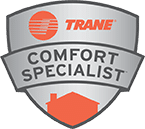The choices you make when it comes to heating and cooling your home are not just about comfort; they are also about sustainability, long-term cost savings, and responsible resource management. In this guide, we will delve into the key factors that every homeowner should consider when assessing a new home’s heating and cooling solutions.
1. Climate Zone
Some regions experience distinct seasons, while others have more moderate year-round temperatures. In areas with pronounced seasons, HVAC systems must be capable of transitioning between heating and cooling efficiently. In contrast, areas with milder climates may require less powerful systems.
Humidity levels also vary significantly across climate zones. High humidity can make indoor living uncomfortable, hence the need for effective dehumidification in cooling systems. Conversely, humidification may be necessary in arid regions so as to maintain indoor comfort.
Additionally, before moving into a new home, inquire whether the previous owners or builders may have adopted specific strategies or technologies to cope with unique climate challenges in the region. This can be invaluable when designing and outfitting your new home’s HVAC system.
The climate zone also influences the environmental impact of your heating and cooling choices. If you are contemplating moving to an area that heavily relies on fossil fuels for energy production, opting for renewable energy sources or highly efficient systems can help reduce your carbon footprint.
2. Energy Efficiency
Heating and cooling systems come with efficiency ratings that indicate their performance. For heating systems, you’ll often encounter AFUE (Annual Fuel Utilization Efficiency) ratings, while for cooling systems, you’ll find SEER (Seasonal Energy Efficiency Ratio) ratings. Higher AFUE and SEER ratings indicate greater energy efficiency. We recommend choosing an HVAC system with high AFUE and SEER ratings to minimize energy consumption.
We also recommend exploring advanced HVAC technologies that enhance energy efficiency. For heating, consider condensing furnaces, as they can capture and utilize waste heat. For cooling, look into variable-speed air handlers and inverter-driven compressors, as they can adjust output to match the specific cooling needs of your San Antonio home.
3. Sizing
An oversized HVAC system may heat or cool the space quickly. However, it will cycle on and off frequently, leading to reduced efficiency, increased wear and tear on equipment, and less consistent temperature control. Oversized systems also feature higher upfront costs.
On the other hand, properly sized systems provide several benefits, including precise temperature control, consistent comfort, energy efficiency, and longevity for the equipment. Right-sized systems also operate more efficiently because they match your home’s heating and cooling load.
You should also consider buying zoning or multi-zone systems if your home has varying heating and cooling needs in different areas. These systems allow you to customize temperature control for specific rooms.
4. Insulation
Various insulation materials are available, each with its own characteristics and advantages. Common insulation materials include fiberglass, cellulose, foam board, spray foam, and mineral wool. Your choice of insulation material should be based on cost, insulation performance, moisture resistance, and local availability.
Effective insulation should have proper air sealing. Air leaks in your home’s envelope, such as gaps around windows, doors, and utility penetrations, can compromise the effectiveness of the insulation. You should seal these gaps with weatherstripping, caulk, or foam insulation to prevent air infiltration and ensure the insulation functions optimally.
However, you should note that proper installation is crucial for the insulation to perform effectively. Therefore, hiring experienced contractors who understand the specific requirements of your chosen insulation material is essential to achieving the desired results.
5. Ventilation
Ventilation is crucial in controlling indoor humidity levels. Excessive moisture can lead to mold growth and damage your home’s structure. Proper ventilation systems prevent moisture buildup, especially in bathrooms and kitchens. They also help eliminate indoor air pollutants like volatile organic compounds (VOCs), carbon dioxide, and allergens from your home, resulting in good indoor air quality.
We recommend integrating your ventilation system with your heating and cooling systems. Some HVAC systems can work with ventilation systems to distribute conditioned air effectively. However, it is worth noting that some ventilation systems can produce significant noise. Therefore, make sure to choose quiet ventilation options or install noise-reducing features to maintain a peaceful indoor environment. Also, make sure to explore smart ventilation controls that adjust ventilation rates based on occupancy, outdoor air quality, and indoor conditions. These systems can optimize energy use while maintaining indoor comfort.
6. Thermostat Controls
Programmable and smart thermostats can contribute to significant energy savings. They allow you to set back the temperature when you’re not at home or adjust it automatically based on your daily routines. Smart thermostats, in particular, can adapt to your habits and optimize energy use.
Many smart thermostats can also integrate with other smart home devices and systems, including voice assistants like Alexa, home automation platforms like Apple HomeKit, and HVAC equipment. This integration allows for centralized control and automation of your home’s heating and cooling systems.
Smart thermostats can also provide detailed energy usage data and insights. This information can help you track your energy consumption, identify trends, and make informed decisions about optimizing your HVAC system’s efficiency.
7. Costs
Higher-efficiency HVAC systems often have a higher initial cost but can lead to substantial long-term savings on energy bills. You should consider the payback period and potential return on your investment when choosing between standard and high-efficiency systems.
Installation costs include labor, materials, permits, and any necessary modifications to your home’s infrastructure. The complexity of the installation can impact these costs. You should also budget for annual or semi-annual maintenance costs, which can vary depending on the complexity of your HVAC system. Maintenance fees typically cover inspections, cleaning, and minor repairs. Unexpected repairs can also occur over the lifespan of your system. Having a contingency fund for repairs is prudent to avoid financial surprises.
8. Environmental Impact
Different heating fuels emit varying amounts of carbon dioxide (CO2). Natural gas and propane emit CO2 when burned, contributing to climate change. However, electric heat pumps and systems that use renewable energy sources have lower or no direct CO2 emissions, making them more environmentally friendly options.
The type of refrigerant used in your cooling system can also impact the environment. Older refrigerants like R-22 contribute to ozone depletion and are being phased out. Newer refrigerants with lower global warming potential, such as R-410A or R-32, are more environmentally friendly.
It would also be best to consider heat recovery systems like heat recovery ventilation (HRV) or energy recovery ventilation (ERV). These systems capture and reuse heat that would otherwise get lost, improving energy efficiency and reducing energy demand.
9. Local Regulations
Building codes dictate the standards and specifications for construction and renovation projects, including the installation of heating and cooling systems. These codes cover system design, installation, ductwork, insulation, and ventilation. Familiarize yourself with the relevant local building codes to ensure your system meets the requirements.
You should also be well-versed in the local permitting process, which may involve submitting detailed plans and specifications for your HVAC system. Be prepared to work with local permitting agencies to secure the necessary approvals.
Rely on the Best
At Air Authority, A Riteway Service Company, we have NATE-certified technicians who arrive on time for appointments, provide clear explanations, and maintain a respectful attitude. Our company has received positive feedback from past clients, demonstrating a history of quality service. You can check our website for testimonials of our great work. In addition, we provide detailed, written estimates for all projects, including costs, labor, and any necessary equipment or parts. This helps us build trust with our clients.
Don’t overlook the critical aspects of heating and cooling! Contact Air Authority, A Riteway Service Company today for the best HVAC services in San Antonio.





